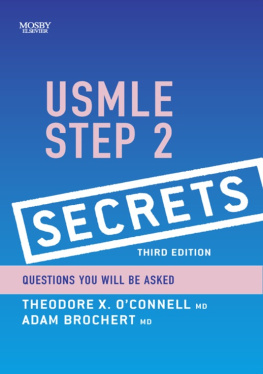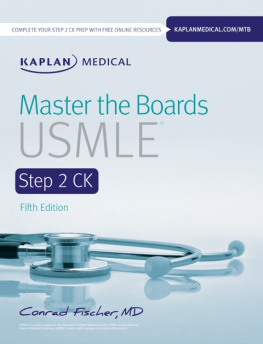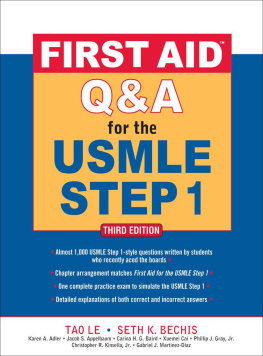These secrets are 100 of the top board alerts. They summarize the concepts, principles, and most salient details that you should review before you take the Step 3 exam. Understanding of these Top Secrets will serve you well in your final review.
1. Smoking is the number-one cause of preventable morbidity and mortality in the United States (e.g., atherosclerosis, cancer, chronic obstructive pulmonary disease).
2. Alcohol is the number-two cause of preventable morbidity and mortality in the United States. More than half of accidental and intentional (e.g., murder and suicide) deaths involve alcohol. Alcohol is the number-one cause of preventable mental retardation (fetal alcohol syndrome); it also causes cancer and cirrhosis and is potentially fatal in withdrawal.
3. In alcoholic hepatitis the classic ratio of aspartate aminotransferase (AST) to alanine aminotransferase (ALT) is greater than or equal to 2:1, although both may be elevated.
4. Vitamins: Give folate to reproductive-age women to prevent neural tube defects. Watch for pernicious anemia, and treat with vitamin B12 to prevent permanent neurologic deficits. Isoniazid causes pyridoxine (vitamin B6) deficiency. Watch for Wernicke encephalopathy in alcoholics, and treat with thiamine to prevent Korsakoff dementia.
5. Minerals: Iron-deficiency anemia is the most common cause of anemia. Think of menstrual loss in reproductive-age women and of cancer in men and older women if no other cause is obvious.
6. Vitamin A is a known teratogen. Counsel and treat reproductive-age women appropriately (e.g., take care in treating acne with the vitamin A analog isotretinoin).
7. Complications of atherosclerosis (e.g., myocardial infarction, heart failure, stroke, gangrene) are involved in roughly one half of deaths in the United States. The primary risk factors for atherosclerosis are age/sex, family history, cigarette smoking, hypertension, diabetes mellitus, high LDL cholesterol, and low HDL cholesterol.
8. Diabetes leads to atherosclerosis and its complications, retinopathy (a leading cause of blindness), nephropathy (a leading cause of end-stage renal failure), peripheral vascular disease (a leading cause of limb amputation), peripheral neuropathy (sensory and autonomic), and an increased incidence of infections.
9. Although hypertension is most often mild or moderate and clinically silent, severe hypertension can lead to acute problems (known as a hypertensive emergency): headaches, dizziness, blurry vision, papilledema, cerebral edema, altered mental status, seizures, intracerebral hemorrhage (classically in the basal ganglia), renal failure/azotemia, angina, myocardial infarction, and/or heart failure.
10. In milder cases, lifestyle modifications (e.g., diet, exercise, weight loss, cessation of alcohol/tobacco use, elevation of head of bed) may be able to treat the following disorders without the use of medications: hypertension, hyperlipidemia, diabetes, gastroesophageal reflux disease (GERD), insomnia, obesity, and sleep apnea.
11. Arterial blood gas analysis: In general, pH tells you the primary event (acidosis vs. alkalosis), whereas carbon dioxide and bicarbonate values give you the cause (same direction as pH) and suggest any compensation present (opposite of pH).
12. Exogenous causes of hyponatremia to keep in mind: oxytocin, surgery, narcotics, inappropriate IV fluid administration, diuretics, and antiepileptic medications.
13. EKG findings in electrolyte disturbances: tall, tented T waves in hyperkalemia; loss of T waves/T-wave flattening and U waves in hypokalemia; QT prolongation in hypocalcemia; QT shortening in hypercalcemia.
14. Shock: First give the patient oxygen, start an IV line, and set up monitoring (pulse oximetry, EKG, frequent vital signs). Then give a fluid bolus (1 L normal saline or lactated Ringer solution) if no signs of congestive heart failure (e.g., bibasilar rales) are present while you try to figure out the cause if it is not known.










